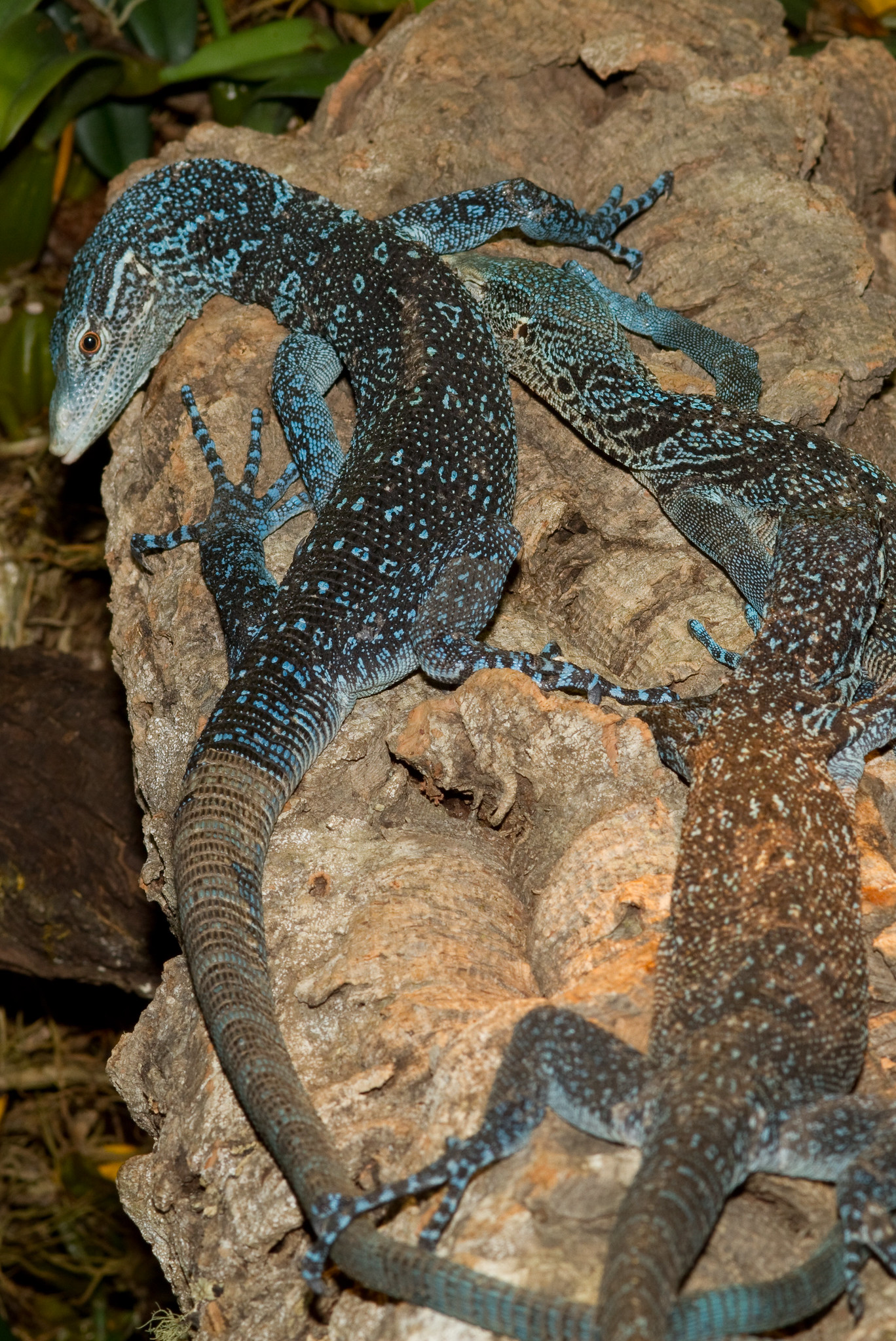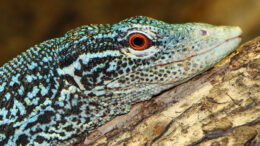Reptiles are extremely popular in the global pet trade. People love them — love them to death.
Thanks to the increasing demand for reptile pets, many species are now threatened with extinction. Among these are the approximately 80 species of varanids, or monitor lizards, from Africa, South and Southeast Asia, and parts of Oceania.
While many monitors reach enormous sizes — the massive Komodo dragon (Varanus komodoensis) being the largest — some are considerably smaller and seen as easier to maintain in captivity. This includes the tree monitors, a group of nine brilliantly colored species that evolved on isolated islands. Their stunning appearance, small size, prehensile tails, and seemingly intelligent nature mean they’re more and more sought after — by any means possible, legal or illegal.
Our research focuses on the plight of the blue tree monitor (Varanus macraei). This intricately patterned species, which grows to a length of about 3.5 feet, lives mainly in trees and is only found on Batanta Island and some of its small offshore islands, in the easternmost part of Indonesia. It likely has the most restricted range of any monitor lizard.
The blue tree monitor was only described scientifically in 2001, based on specimens found in the wildlife trade in the United States. It was named after Duncan R. MacRae, a reptile trader who was instrumental in the species entering the international pet trade. The specimen used to describe the species was caught on Ayem Island (off Batanta) and entered the international market via a trader on Batanta.
Under two decades later, in 2017, the IUCN listed the species as endangered. Researchers warned that this little varanid is in serious decline due to illegal over-harvesting in its small range, with the demand coming from traders and hobbyists. The species is so rare that researchers spent a few days between each sighting.
Our research highlights the volume of blue tree monitor trade and the issues in controlling it.
A Snapshot of the Market
Earlier this year we investigated the online trade in Indonesia to spotlight the threats this species faces and illuminate the need for urgent and more effective measures to prevent poaching and illegal trade.
On June 25 we conducted a search for blue tree monitors for sale online within Indonesia. Because there is no legal harvest for the species, and the commercial trade in captive-bred and captive-born specimens is mainly (or even exclusively) for the international market, we expected to find very few.
We were wrong.
Finding blue tree monitors for sale online was simple. We found 18 advertisements on seven different platforms. Several of the sellers indicated that they had more individuals available or that additional specimens could be obtained if required.

Ten sellers were commercial traders or established pet shops. One appeared to be a hobbyist. Sellers were mostly based on Java, with seven in the Greater Jakarta area, and one each in Semarang, Jember and Surabaya (the last of which is over 1,240 miles, or 2,000 kilometers, from Batanta). One trader was based in Banjarmasin, on the island of Borneo.
All advertisements and posts were written in Indonesian, with some English terminology widely understood in the reptile hobbyist community.
All but two of the lizards for whom we were able to establish an age — or for whom age was given — were adults. Five sellers specified that their animals were “jumpy” or “shy,” and two added that the animals were “damaged.” None indicated that the animals were tame or that they were captive-bred. This all suggests it was wild-caught individuals being offered for sale. While four of the sellers indicated that the species was “rare” or “super duper rare,” none indicated that capture was prohibited, that trade was strictly regulated in Indonesia, or that its export was covered by CITES.
Research like this allows us to develop recommendations for the government of Indonesia and importing countries where demand driving the trade can, and should be, addressed. Our aim was to find what platforms offered this species for sale, where traders were based, and who offers them for sale (hobbyists, commercial traders, pet shops, etc.) and ultimately, to inform importing countries of the illegal nature of this trade.
Mystery Sourcing
So where do the traded lizards come from?
As we saw in our snapshot sampling, and from an abundance of literature, there’s ample evidence that registered reptile breeders in Indonesia often illegally remove animals from the wild and launder them into the global trade by claiming they were bred in captivity.
This is not uncommon. While shipments of laundered reptiles from Indonesia are sometimes detected and seized, officials in importing countries often grapple with proving the animals were not bred in captivity. This method of smuggling is rife and a major obstacle in the fight against reptile trafficking.
How many lizards are we talking about? Data from the CITES wildlife trade database shows that Indonesia reported the export of 3,167 blue monitor lizards for commercial purposes from 2010-2020 (inclusive). Of these 1,199 were reported to have been bred in captivity (i.e., they were second-generation offspring, bred out of parents who themselves were bred in captivity) and 1,968 as being born in captivity (bred from parent(s) who had been wild-caught). It’s likely that at least most of the blue tree monitors exported from Indonesia are in fact wild-caught.
Totally protected, Blue Tree Monitors Varanus #macraei are illegally captured to supply international demand for pets, violating #Indonesia’s #wildlife laws. Said to have the smallest range of any monitor #lizard, locals report major declines. #reptiles https://t.co/z7AMkQzTL8 pic.twitter.com/J5v0ibwXE4
— Monitor Conservation Research Society (@MCRSociety) July 5, 2022
In a recent study, Indonesian ecologist Evy Arida and colleagues spoke with lizard collectors living on the island of Batanta, who reported that blue tree monitors used to be available in the vicinity of their homes some 30 years ago, prior to their popularity in the pet trade. These same people told the researchers that blue tree monitors have become very scarce; they now must travel by boat to find the lizards in remoter parts of the species’ range.
The research shows that local collectors specifically target blue tree monitors and purposefully search for them to sell to traders who eventually export the species. Their assessment also shows that while these collectors do make some welcome cash from their illegally sourced monitor lizards, none of them rely solely on blue tree monitor collection for income. Instead they regularly sell fish, vegetables and fruit in the markets, and tree monitors are an occasional but dwindling bonus.
How Do We Protect Them?
Clearly the species is in grave danger.
And yet these lizards still generate big profits for some people. Research published in 2015 estimated that the total retail value of the international trade in blue monitor lizards is more than $100,000 a year, based on a retail price of $750 per lizard.
New Guinea villagers receive a very small proportion of the final sale. This provides little incentive for local people to harvest these species sustainably or to protect the habitats in which they live.
Blue tree monitors, or Varanus macraei, are elusive, arboreal reptiles that live on the small, Indonesian island of Batanta. Though closely related to the black tree monitor and green tree monitor, they are by far the rarest. pic.twitter.com/9poV4TDOXc
— Potter Park Zoo (@potterparkzoo) August 7, 2021
Moreover, illegal trade can undermine sustainable harvest and community-based conservation initiatives.
There is clearly little in the way of disincentive as well, as efforts to prevent the illegal capture and trade in the species appear to be minimal.
Obviously continual illegal take of this species could potentially lead to its extinction in the wild. To prevent this, the Indonesian government must start enforcing existing policies prohibiting its capture.
In addition, we see three opportunities to prevent further decline in the wild population of blue tree monitors:
First, the government of Indonesia should propose the species be listed in Appendix I of CITES to assist in preventing international trade.
Second, the European Union, which currently has a temporary suspension on blue monitor imports, should make the ban permanent.
Finally, the United States should protect the blue tree monitor under the Endangered Species Act. As a major importer of such reptiles from Indonesia, its listing of the monitor would deter demand in the country and have positive impacts on conservation of the species.
On top of these three steps, we recommend all other major consumer states explore, develop, and put into action strategies to reduce demand.
Similar steps already protect many species around the world from the covetous eyes of collectors. It’s time to extend that to the blue tree monitor — an evolutionary marvel that deserves to thrive in its native habitats instead of lonely cages around the world.
Previously in The Revelator:
Wildlife Trafficking: 10 Things Everyone Needs to Know



